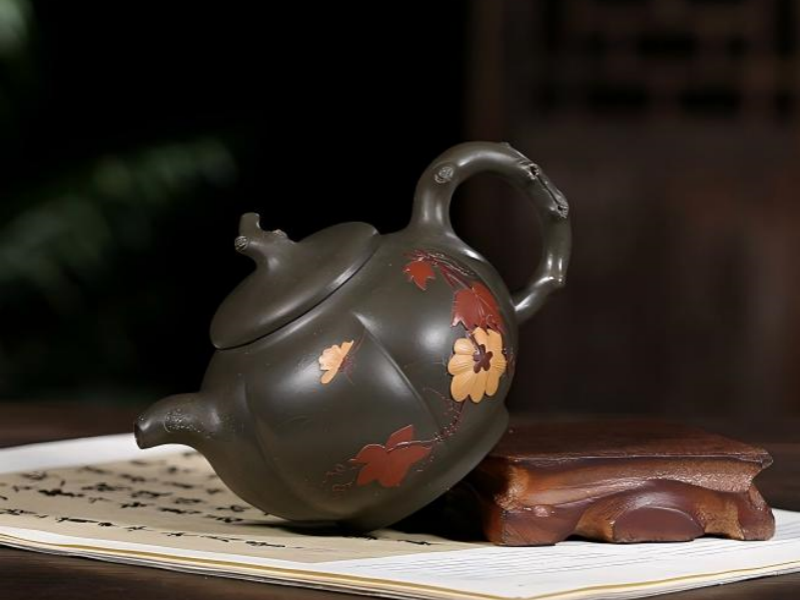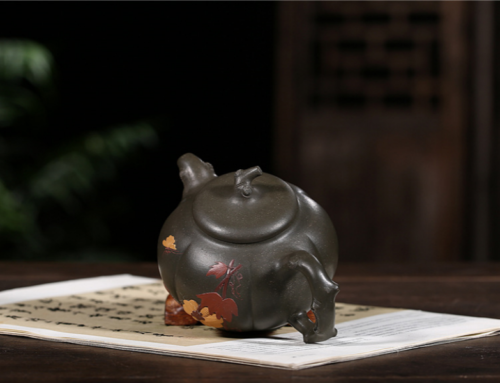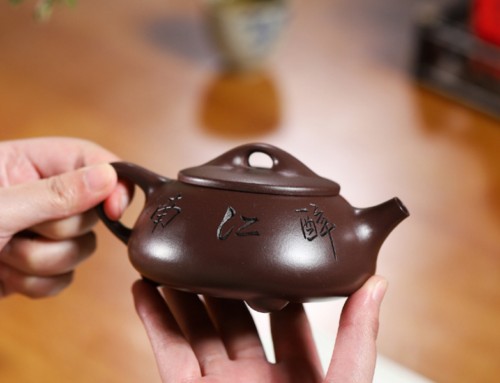A Famous Yixing Pot Artist and her Collectors: The Ancient Masters and their Legacy
What makes Yixing clay so special?
Yixing pottery (aka Zisha (紫砂), or purple sand pottery) is one of the most famous artforms to come out of China. For centuries, their teapots have captured the hearts of tea drinkers, collectors and artists alike. But what is it that makes Yixing pottery so special? And why are famous Yixing pot artists and collectors revered in art and tea culture circles?
The Magic of Yixing Clay
Yixing clay is the heart and soul of every Yixing teapot. It is a blend of several natural, unique clays found in the region surrounding Yixing in China’s Jiangsu Province. There are three main types of clay, called zisha (meaning purple sand): purple clay, red clay and green clay. Each of these types of clay have slightly different mineral contents, which gives Yixing pots their characteristic textures and natural colors. One of the most unique qualities of Yixing clay is its porosity. Yixing pots will take on the scent and taste of the tea, allowing a well-used Yixing teapot to flavor each brew and enhance it over time. Because of this, tea enthusiasts will dedicate each of their Yixing pots to a single type of tea.
Craftsmanship: Where Art Meets Function
Yixing pottery is more than just the clay. It’s the pairing of beautiful and unique clays with a tradition of stunning craftsmanship that stretches back several hundred years. Unlike most pottery, Yixing teapots are hand-built. Artists will sculpt, carve, paint and assemble the teapots by hand using only wooden paddles, carving tools and their own fingers, making each Yixing teapot a unique work of art. Hand-building and decorating Yixing pottery is a time-consuming process that takes an incredible amount of skill and patience – days or even weeks can pass before a teapot is finished. Fun Fact: A REAL Yixing teapot is never glazed on the inside; the taste-enhancing properties of the unadulterated clay yields a much stronger brew.
Cultural significance

Yixing teapots have been cherished in China for centuries since the Ming dynasty. These teapots are not considered mere objects for brewing tea; well-known Yixing Utility & Creative teapots are in itself symbolical objects of Chinese cultivated elegance, artisanship and the expression of the coexistence of nature & human art. For collectors of Yixing teapots or even those classified as “老茶鬼” (masters of tea), finding a Yixing teapot in one’s collection is to many, the final bastion of taste and prestige of one’s perception. “紫砂壶不应该是用来泡茶的器具,而应该是值得陪伴一生的生活伴侣。” – 紫砂壶说 “A Yixing teapot is not used to brew tea, it is a companion for life.” – Traditional Chinese Proverb
Why are Famous Yixing Pot Artists/Collectors So Respected?
The answer lies in the artistry and tradition, the way each artist infuses their individuality into each teapot. Each creation reflects the artist’s sensibility and skill. In doing so, the collector is helping to preserve a legacy and keeping masterpieces by established Yixing potters desirable. Yixing pottery could not be so special without its unique clay, the inventiveness and workmanship of its artists, and its relationship to Chinese cultural traditions. This foundation allows us better to understand why Yixing’s famous pot artists and collectors are so famous—and why people still find their stories so compelling all over the world.
Yixing Masters
He is recognized as a first generation of Yixing pottery artist.
Early masters: Shi Dabin and Chen Mingyuan
Shi Dabin (1573–1648): The Pioneer Shi Dabin Ni’er Xiang Zun 石大賓 · 泥兒香尊 Shi Dabin is often considered the founding master of Yixing teapots. He lived during the late Ming dynasty, when the art began to flourish. Shi Dabin brought the teapot from obscurity to acclaim, turning it into a work of art. His works are admired for their elegant simplicity, harmonious proportions, and understated beauty. Shi Dabin’s hallmark style—rounded shapes, smooth surfaces, and subtle ornamentation—became the template for generations of artists.

Today, collectors prize Shi Dabin’s teapots for their historic significance and timeless elegance. Auction records show that authentic Shi Dabin pots have sold for hundreds of thousands of dollars, making them some of the most valuable Yixing pieces in existence. Chen Mingyuan (1662–1735): The Innovator If Shi Dabin was the pioneer, Chen Mingyuan was the innovator. Chen took Yixing pottery to new heights with his imaginative creations. His teapots are expressive and playful, resembling objects from nature—bamboo, tree trunks, fruits, and even animals. Chen’s technical prowess enabled him to achieve intricate details and realistic textures. His pieces close the gap between art and utility, form and function.
Chen Mingyuan’s influence is evident in the lively, naturalistic styles embraced by many contemporary Yixing artists. His works are coveted, not only for their beauty but for their ingenuity.
Modern Masters: Jiang Rong and Gu Jingzhou
Jiang Rong (1919–2008): The Queen of Yixing Teapots Jiang Rong is one of the few women to reach the status of master maker in the male-dominated world of Yixing pottery. Her pots are celebrated for their delicate detailing and lyrical beauty. A specialist in floral and animal motifs, Jiang took inspiration from the natural world. Her “Lotus Teapot” is hailed as a masterful work of technical skill and aesthetic sensibility.
Jiang Rong’s achievements extend beyond her pots. She also trained a number of younger artists, guaranteeing the future of Yixing pottery. Gu Jingzhou (1915–1996): The Modern Icon Gu Jingzhou is by all accounts the most famous Yixing pot artist of the 20th century. Over a long career, he revived old techniques and set new standards of perfection. Gu’s teapots are known for their ideal proportions, polished surfaces, and balanced forms. He made a specialty of the “plain beauty” style, which shows off the natural color and texture of the clay.
For collectors, Gu Jingzhou’s teapots are the gold standard. In 2010, one sold at auction for over $2 million dollars.
How to identify authentic works from the famous Yixing pot artists?
Being the eminent artists that their works are highly valued, so many imitations of varying degrees appear on the market. How can you identify the real work of a famous Yixing teapot artist?

| Feature | Authentic Yixing Pot | Fake/Replica Pot |
|---|---|---|
| Clay | Natural zisha. Unglazed clay. | Artificial clay or painted/glazed to fake. |
| Seal/Signature | Hand-carved into the clay. Clear and sharp. | Stamped seals. Often blurry, double-stamped, or missing. |
| Craftsmanship | Seams are invisible and handle/spout are well balanced. Pots are unique. | Moulded/factory-made pots. Components and seals are often repeated. |
| Provenance | Big-name pots have documented origin and one can refer to some historical occasion. | No history behind the pot and lineage is often vague or untrustworthy. |
Data Source: Jiangsu Provincial Quality and Technical Supervision Bureau – Yixing Purple Clay Product Quality Standards and Authentication Guidelines (http://scjgj.jiangsu.gov.cn)
Data Source: China Ceramics Industry Association – Traditional Craft Standards for Yixing Teapot Manufacturing and Authentication Methods (http://www.ccia.org.cn)
Data Source: Yixing Ceramics Industry Association – Official Registry of Certified Yixing Artisans and Authentication Protocols (http://www.yxcx.cn)
Case study: in 2018, a collector from Hong Kong picked up a teapot marked with Shi Dabin’s seal at a market. When the teapot was submitted to experts for assessment, it was confirmed to be an original work. It was auctioned off subsequently and sold for more than $500,000, demonstrating the incredible value and excitement of genuine Yixing work. The legacy of these famous Yixing pot artists stands as a legacy to their creativity and skill passed down the generations. Their decorated careers remain a constant source of inspiration to newer generations of artists and collectors. With each pot, their story remains imprinted with the work of art, providing a living bridge to China’s culture.
List of Yixing pot collectors
Besides the familiar Yixing pot artists and the collectors-that is, collectors of world renowned masterpieces of Chinese painting and calligraphy, there are others who may be called devotees” the men and women of passion who have pursued, purchased, stored, and preserved the works of Guangdong in so invested handicrafts-the Yixing pots. Among these spirits, apart from the descendants of the makers, where could they be otherwise found? If such were not the case, the Yixing teapot never would have been preserved for appreciation in the clarity of my lens. The tales of such people indeed form a checks pattern blend of passion within the palimpsests of their works: the shrewd interests of a doer great in accomplishment, a nose for discrimination, the leaning Titian crane of my eagle’s eye on the Enjoyment Hall, the potter’s art of Yixing, of someone whose family had built fences of tea and warehouse walls of purple clay …Such stories are really but a single facet on the unfold Yixing teapot!
Why do people collect Yixing teapots?
To collectors of Yixing teapots, it is a passion that lasts many of them a lifetime. Collectors pursue these pottery pieces for different reasons:
Quote: “Collecting Yixing teapots is like collecting poetry in clay each has its own story, each has its own flavour.” — Anonymous collector.
Famous collectors and their influence

For centuries, yixing teapots have been cherished by emperors, literati, intellectuals, artists and collectors. These collections over the years have influenced tastes, spawned new trends and even influenced Yixing production itself. Past Collectors Emperor Qianlong (1711–1799): The Qing dynasty emperor and celebrated art patron was a noted tea aficionado. Legend has it that he had dozens of Yixing teapots and was known to commission custom works from the best artist of his time. Some of the imperial ware have since been conferred national treasure status and are on display at museums such as the Palace Museum in Beijing. Literati and Scholars: Many Ming and Qing dynasty scholars and poets cherished Yixing teapots for their humble artistry. Often times, they would engrave their own poetry or calligraphy on the pots, making the teapots a collaborative piece of art. Modern collectors Wu Hufan: As one of the four great masters during the Republic of China, Wu’s collection of ceramics was reputedly the greatest during the Republican era. The attribution and connoisseurship techniques that he applied to works in yigxing purples, making use of, entering a house, character, number, inscription, model, have become a standard for collectors of yixing ceramics. When a yixing teapot is well-made, it will absorb the taste of the tea brewed in it, reflect the character of the creator’s design techniques, and in everyday use reveals the subtlety of the art. Modern collectors, adhering to this aesthetic, are very eager to collect. This atmosphere has gradually spread from Hong Kong to Taiwan, Europe, and North America. The pursuit of Purple Sand Teapots has already fully established its position as an “artistic work” through the auction market. Auction companies (Christie’s or Sotheby’s, for example) have set-up specialty auctions for works & wares of kaiken teapots apart from the glut of auctions across the world in other wares. The response has been enthusiastic. A number of classic teapots have fetched very high auction prices, ranging from hundreds of thousands of yuan to millions.
Tips for Aspiring Yixing Pot Collectors
If you’re inspired to start your own collection, here are some practical tips to guide you:
Case in point: In 2015, a first-time female collector in Shanghai bought a rather modest-looking Yixing teapot from a market stall for under $100. After diligently researching her pot and discussing it with other collectors, she realized that it was one of the early works by Jiang Rong. Now her pot has been appraised for over $50,000. In the collecting scene, with the right knowledge and determination you can oftentimes turn your humble purchase into something more significant and this prized teapot is a testament of that. Collectors in some ways are the lifeblood of the Yixing pottery world. It is their love and appreciation for the works of famous Yixing pottery artists that keeps these fine works safe for future generations to appreciate, study and enjoy.
Modern yixing teapots
The Yixing teapotThe Yixing teapot market has grown from a local pursuit to a world noted phenomenon. Today, famous Yixing pot artists and collectors are leading a lively market mixing art, history and investment opportunity. If you are thinking about entering the fascinating world, it is essential that you understand how Yixing pots are priced, exchanged and stored!
How Yixing Pots Are Valued and Traded
Record-breaking auctions and sales
Yixing teapots have received keen international appreciation, resulting in some astounding results. In 2010 a Gu Jingzhou teapot sold at auction in Beijing for over $2 million. Other rare pieces by Shi Dabin and Chen Mingyuan have sold for hundreds of thousands of dollars, in particular when there was firm provenance or documentation. Chart: Top Auction Prices for Yixing Teapots (2010–2023) Year | Artist | Sale Price (USD) | Auction House 2010 | Gu Jingzhou | $2,000,000+ | Beijing Poly 2015 | Shi Dabin | $800,000 | Christie’s 2018 | Jiang Rong | $500,000 | Sotheby’s 2021 | Chen Mingyuan | $1,200,000 | China Guardian Note: prices are quoted as of examples with firmly established provenance, incomplete and unrestored.

Where to Find Authentic Yixing Teapots
For new or unknowing collectors alike, purchasing genuine yixing teapots is both an art and a science. Here are the most reliable places to go. Auction Houses: Christie’s and Sotheby’s all have yixing teapots in their Asian art sales. Their sales catalogue will have information about the provenance and authentication of the work. Gallery dealers: well established brands in China, Hongkong or Taiwan. Experienced dealers have built a reliable connection with collectors over time. The reliable dealers are directly connected with the artist(s). Readers are encouraged consult with your art dealer if you have any question about the authenticity of the works before making purchase.
How to Buy: Tips for New Collectors in the Current Market
Case Study: in 2022 a collector in London purchased a teapot from a local auction for $2,000, which after expertise was confirmed to be a rare, early work by Chen Mingyuan. It was resold in a large auction house and made over $100,000. Proof that with enough knowledge, patience, and research the Yixing market can be extremely profitable. The current Yixing pot market is one of both inheritance and innovation, where the collection and appreciation culture formed by generations of highly-esteemed Yixing pot artists and collectors influences the tastes and values of the present generation as well as the future of the development of the art of Yixing pots.
Famous Yixing Pot Artists and Collectors FAQs
Have Questions? It’s only natural to have many pressing questions about famous Yixing pot artists and collectors. After all, the world of Yixing pottery is steeped in tradition, art and intrigue. Here are some of the most frequently asked questions, practical advice that provide deeper insight into the world of Yixing for beginners and long-time fans alike.

| Feature | Authentic Yixing Pot | Fake/Replica Pot |
|---|---|---|
| Artist’s Seal | Hand-carved; unique to artist | Stamped, generic, missing |
| Clay (Texture) | Easy to see sandy clay; porous. Unglazed. | Smooth (unglazed); glazed; unnatural; polish |
| Craftsmanship | Appears seamless and balanced; unique craft signature of the artist | Machine pattern; repeats; |
| Provenance | Verifiable documentation | Lack of provenance |
Data Source: Jiangsu Provincial Market Supervision Administration – Yixing Purple Clay Product Quality Standards and Artist Certification Registry (http://scjgj.jiangsu.gov.cn)
Data Source: China Ceramics Industry Association – Traditional Handcraft Authentication Guidelines and Artist Seal Verification Database (http://www.ccia.org.cn)
Data Source: Yixing Ceramics Museum – Historical Documentation and Provenance Verification for Traditional Yixing Pottery (http://www.yxbwg.com)
In short, acquiring knowledge on identifying, collecting and caring for Yixing teapots is absolutely indispensable to the enjoyment of this unique art form. Whether you’re drawn by the aesthetics of the teapots themselves, a love of history or the thrill of the hunt, you’ll find learning to identify, collect and care for Yixing teapots richly rewarding.
Famous Yixing teapot artists and collectors: Yixing teapot artist has a long lasting history but is also present in our day and age
Jiangsu Province to Hong Kong to New York to burrow kilns to auctions yet Yixing teapot artist is live and lively with the souls of Yixing teapots through the artist and collectors wonder at Yixing teapots. Yixing Zisha: Potter’s joy, potter’s woe Yixing teapots are not just a recipients for tea, but rather living works of art sculpted by hand and by the mind of the master. The very qualities of the zisha clay and the mind of master like Shi Dabin, Chen Mingyuan, Jiang Rong and Gu Jingzhou made these humble pots to object of desire around the world. They have inspired and still do for many generations in and out of China. Collectors, too, have a cherished role in this legacy. By searching for, conserving and sharing these treasures, they ensure that the stories, skills and creativity of Yixing’s best artists are not forgotten. Their collections are living museums that link the past to the present and keep the flame of tradition burning bright.












